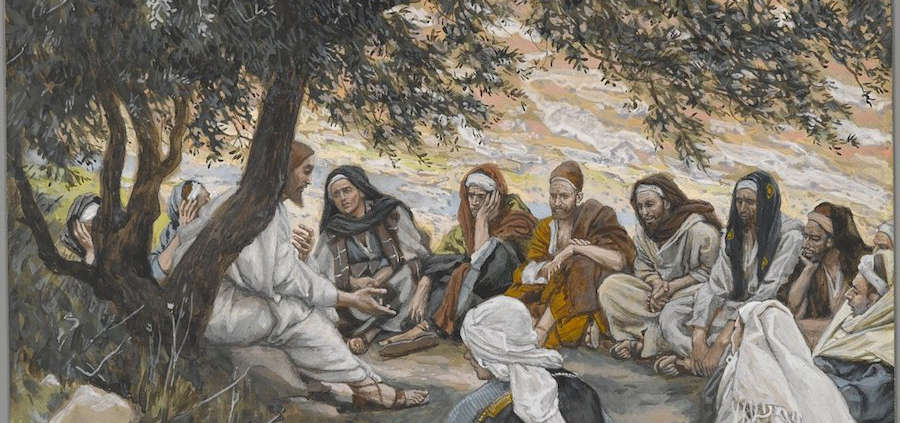Mystery and Simplicity by Michael Centore
This week at our small Christian community gathering, we pondered an expression of the First Letter of John: “We do know that when it is revealed we shall be like him, for we shall see him as he is” (3:2). To see God “as he is” feels like quite a leap, a stepping through to the other side of the mirror Paul employs in his First Letter to the Corinthians: “For now we see in a mirror, dimly, but then we will see face to face” (1 Cor 13:12).
The other two readings for the Fourth Sunday of Easter offer clues for how to realize a foretaste of this revelation here on earth. In the opening reading from the book of Acts, we hear: “There is no salvation through anyone else, nor is there any other name under heaven given to the human race by which we are to be saved” (4:12). By pledging his divine name, Joseph Ratzinger writes, “God establishes a relationship between himself and us. He puts himself within reach of our invocation.”
The pseudonymous author “A Monk of the Eastern Church” says that “it is above all the Acts of the Apostles which could be called the book of the name of Jesus.” He explains: “‘In the name of Jesus’ the good news is preached, converts believe, baptism is conferred, cures and other ‘signs’ are accomplished, lives are risked and given. This insistence on the name of Jesus is not a magic formula, for no one can use this name efficaciously if he does not have an interior relationship with Jesus.”
The name of Jesus is thus the first way, the first opening or intimation, as it were, of seeing God “as he is.” It brings us into relationship with the Son, Jesus, who said explicitly: “Whoever has seen me has seen the Father” (John 14:9). To call on Jesus is to call on God; to see Jesus is to see God. The depths of mystery and simplicity in this statement are mutually reinforced: the longer we contemplate it, the simpler it becomes; the simpler it becomes, the more unfathomable it seems.
But what about those of us—the great proportion in the history of the faith—who have never “seen” Jesus, save in an icon or an image or through the mental picture of a word of Scripture? I think here of the Holy Trinity: if we behold one of the persons, by virtue of their coeternity and consubstantiality we behold all three. The inspiration or breath of the Holy Spirit leads us to the Son, who shows us the way to the Father.
In the third reading for the Fourth Sunday of Easter, taken from the Gospel of John, Jesus says, “This is why the Father loves me, because I lay down my life in order to take it up again. No one takes it from me, but I lay it down on my own. I have power to lay it down, and power to take it up again. This command I have received from my Father” (10:18).
As our group discussed these passages, I looked out my window to see trees in bloom in the early evening light and the grass saturated with a deep, life-giving green. I thought of how a few short weeks ago the same view was entirely gray and beige save for a thin thatch of distant spruce, and I wondered if this was not an instance of Christ taking up his life again after laying it down for the winter.
It may not have been seeing him face to face, but in a way, it was: sensing the movement of the Spirit of nature where he abides, I felt the resurrection motif in the passage from John grow more tangible, more present. To be led through the Spirit to the Son, and from the Son to the Father, puts a human face on creation and lends it a human name. As the “Monk of the Eastern Church” writes: “The name of Jesus is an instrument and a method of transfiguration. When we utter it, it helps us to transfigure (without any pantheistic confusion) the whole world into Jesus Christ.”
We return to the First Letter of John with a deeper understanding. “Beloved, we are God’s children now; what we shall be has not yet been revealed” (3:2). Our “adoption” by God has already occurred; our life here is the forum for developing that relationship, for finding paths of correspondence in the metaphors and materials of this world. Though our true selves still stand to be revealed, we can begin the work of receptivity by making space for Christ, striving to acquire his Spirit, and seeking to turn all things over to his Father with humility, gentleness, and love. ♦
Michael Centore is the editor of Today’s American Catholic.





Hi Michael:
Thanks for this. I share the window views and meditative inspirations that provided in our part of the world.
I am well into the “Women in the Church” book. A well written text that certainly takes my back to teaching days.
best wishes in Christ, Jack
Michael, I just saw this. Nice job. I hope everyone else got to see it. Bev